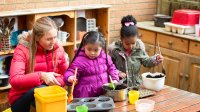7 Ways to Connect Young Students to Nature
Fostering a sense of connection to nature has an impact on students’ well-being and learning—and it can be as easy as bringing in a plant.
Your content has been saved!
Go to My Saved Content.Young children benefit from frequent contact with nature in a variety of ways, including improved physical and psychological well-being. Children who spend more time in nature have lower rates of asthma, depression, and other illnesses. Studies have shown that green space around a school “significantly predicted schoolwide student performance,” including grades and graduation rates.
With these benefits in mind, educators have good reason to bring more nature into their classrooms. For many of us, it can feel like a challenge to add more time in nature into an already packed school day. But bringing nature to children doesn’t have to be time-consuming or logistically challenging. Below are seven easy strategies for connecting your classroom to nature.
7 Tips for Bringing the Outdoors Into Your Day
1. Incorporate nature into classroom routines: You can ensure that your students have access to nature by incorporating it into your daily classroom routines. Try extending the transition to include a little extra outdoor time if you work in an environment where children go outside to transition to other spaces, such as the cafeteria. As you transition, you can encourage students to notice sights and smells around them as they walk or even have them practice moving like different animals.
2. Take a snack or lunch break outside: This is something you can do whenever the weather permits. As you prepare, you can teach necessary skills while indoors, such as sitting on a carpet square or mat and managing any wrappers or other trash that might blow away in a windy environment.
3. Naturalize your indoor space: Instead of bringing your students to nature, bring a little of it to them. You can decorate your classroom with natural images, furniture, and earth-tone colors. Consider displaying photographs of children exploring outside as a reminder to your students of their own connection to the natural world.
4. Use materials from nature: Natural materials can provide interesting sensory experiences in many areas of the classroom. Incorporate twigs, wood slices, or small stones into the block area. Even if you already have a math curriculum in place, there are frequent opportunities to replace plastic manipulatives with natural ones. You could use large seeds instead of plastic chips. Instead of collecting Unifix cubes, kids could gather acorns. Use natural materials for art or building projects to engage children with the diverse textures, shapes, and colors found in nature.
5. Consider a classroom animal: While bringing one or more animals into your classroom is a significant commitment for both you and your class, they can provide a unique connection between your students and nature. Patty Born Selly’s book Connecting Animals and Children in Early Childhood provides an excellent framework for bringing an animal into your classroom.
If a live animal isn’t right for you, consider a virtual class pet. Many zoos and aquariums have livestreams of some of their beloved residents, like the Monterey Bay Aquarium’s otter cam.
6. Bring wildlife to you: You can safely encourage wildlife to visit your classroom. A bird feeder outside of your window can entice visitors, and a few pairs of binoculars and a field guide can serve as a gentle invitation to bird-watching. If you have a bird feeder, just remember to clean it regularly. Virtual nest cams of local birds can also provide a wonderful connection to wild animals in your area if a bird feeder isn't an option.
7. Grow something: Bringing some plants into your classroom, even if you don’t have a green thumb, can completely transform the atmosphere. Studies show that views of green spaces reduce stress, improve attention, and even improve student performance on standardized tests.
From low-maintenance houseplants to edible fruits and veggies, plants can deepen children’s connection to the natural world around them. Pollinator-friendly plants in a window box or outdoor planter can attract bees and butterflies. Do a little research on the plants you choose to make sure that they are nontoxic. Some plants are poisonous or can cause skin irritation if students touch them.
Connection to nature can have a profound impact on all students’ well-being and learning, especially those who are struggling emotionally, academically, or behaviorally. There are many ways for those of us who teach in traditional brick-and-mortar classrooms to incorporate some benefits of nature-based education into our teaching with just a few simple changes.
